BIRDS AS ART BULLETIN #241
SEPTEMBER 8, 2007
Visit www.birdsasart.com
THE JAMAICA BAY WILDLIFE REFUGE (JBWR) IPT REPORT
ON THE ROAD AGAIN
DEPTH-OF-FIELD/AN OLD DOG LEARNS SOME NEW THINGS…
MY USED EOS 1Ds MII FOR SALE/PRICE REDUCED
BEST OF FLORIDA NATURE PHOTOGRAPHY WORKSHOP & TOUR
BAA/ABP II KUDOS
BreezeBrowser 1.7.2 RELEASED
ITEMS FOR SALE
THE ART OF BIRD PHOTOGRAPHY/SOFT COVER EDITION: TEMPORARILY OUT OF PRINT
IPT UPDATES
Contact us by phone at 863-692-0906 (Eastern Time Zone) or by e-mail at birdsasart@att.net or birdsasart@verizon.net. The att e-mail address is best from overseas.
We gladly accept credit card orders by phone 8am till 9pm Eastern Time (8 am till 3pm Fridays).
You can use the PayPal links on the web site to order anything. Just type in the item(s) and the amount. If using your own PayPal account, please send to either of the e-mail addresses above.
Note: maximize this e-mail for best formatting.
Photographic theme: Images from JBWR (& one LaJolla pelican…)
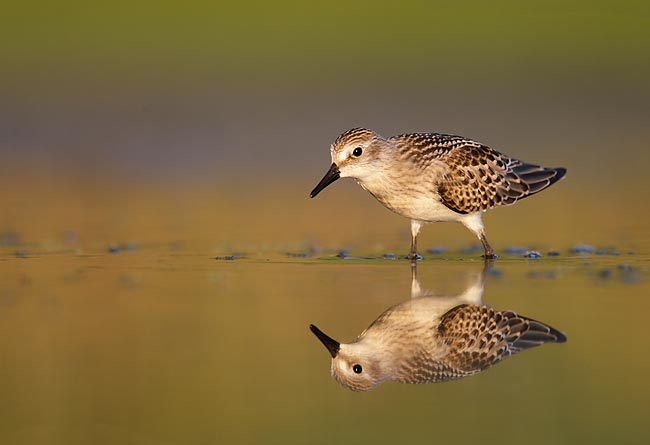
Semipalmated Sandpiper in fresh juvenal plumage, East Pond, Jamaica Bay Wildlife Refuge, Queens, NY
Image Copyright 2007: Arthur Morris/BIRDS AS ART
Canon 500mm f/4L IS lens with the 1.4X II TC and the EOS-1D Mark III. ISO 800. Evaluative metering +1/3 stop: 1/640 sec. at f/5.6. AAFPS (Automatic Autofocus Point Selection aka 45-point AF).
I created this after seeing and being inspired by some small-in-the-frame images created by IPT participant Mike Milicia. Up until that time I had been working with the 2X TC. I liked many of the images made with a wider look in mind. The longer focal lengths are not always better…
THE JAMAICA BAY WILDLIFE REFUGE (JBWR) IPT REPORT
On the afternoon of August 25, I was met by 8 eager photographers to begin the JBWR IPT. All of the participants were IPT veterans. As described in the original Art of Bird Photography, the IPT was timed to coincide with the morning high tides. In mid- to late-August several species of migrant shorebirds arrive in the US. High tides in surrounding Jamaica Bay force the shorebirds to the East Pond where they rest, feed, and preen until the tide begins to drop. Heavy rains the week before left the pond edges wet and muddy, this in addition to the usual goose droppings, PCBs, and jet fuel made getting down and dirty a challenge even for shorebird lunatics like me. The refuge staff worked hard to lower the East Pond water levels to make things better for the birds, the birders, and the bird photographers. Their efforts were appreciated. Having learned that nearby Nickerson Beach was home to a large Black Skimmer colony we spent several half-days there as well. We also spent some wonderful time on Denis Macrae’s back porch photographing Laughing Gulls and Great Egrets. The opportunities there were sup-par but we had two great picnics featuring great NY bagels, chicken salad, and egg salad from the Bay Gull shop on Cross Bay Blvd. in Broad Channel. Denis was a most gracious host and a great time was had by all. I even got to go for a swim when I dropped the top half of the killifish trap in the water (as I usually do…)
With dropping water levels, better and better weather, and fewer photographers each day, conditions at the East Pond improved dramatically. On our last morning about six of us practiced stalking a small group of shorebirds that included Semipalmated, White-rumped and Stilt Sandpipers and Short-billed Dowitchers. In addition to going through the identification and aging of each of the birds, I was able to talk the group through the very fine points of stalking, to explain which were the most desirable subjects, and to tell them exactly what I was doing photographically and why. It was a truly wonderful experience and we eventually got so close to some of the birds that folks could not focus… When the group asked why we had not done that before I explained that it would have been impossible to do so when there were other photographers around as we would have been flushing small groups of birds along the shore (that they had been photographing) as we pursued our subjects in the shallows.
Everyone marveled at the chance to get on the ground and experience the sandpipers and plovers on such an intimate level. And I did too.
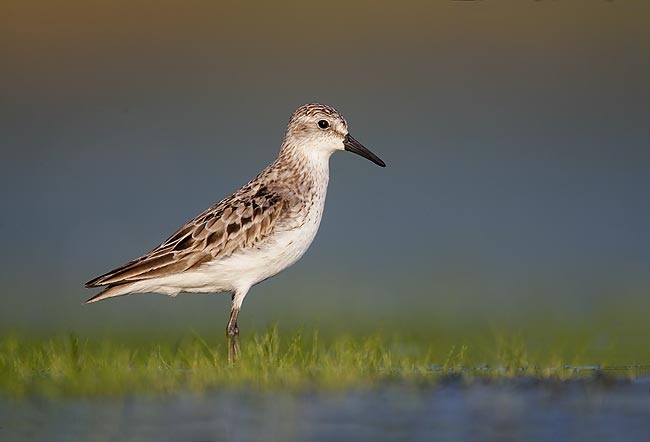
Semipalmated Sandpiper, worn, molting adult, East Pond, Jamaica Bay Wildlife Refuge, Queens, NY
Image Copyright 2007: Arthur Morris/BIRDS AS ART
Canon 500mm f/4L IS lens with the 1.4X II TC and the EOS-1D Mark III. ISO 640. Evaluative metering +1/3 stop: 1/2000 sec. at f/5.6. AAFPS (45-point).
I failed to mention above that I used the Panning Ground Pod (http://www.birdsasart.com/accs.html#The%20Walt%20Anderson%20Panning%20Ground%20Pod )so that I could work comfortably at the bird’s eye level. Intimate images with soft, sweet foregrounds and backgrounds are easy to create when you are on your belly and choose the situation carefully…
If you are confused as to why the bird in the first image in this Bulletin is a juvenile and the bird immediately above is an adult, we humbly suggest that you get a copy of my Shorebirds; Beautiful Beachcombers (http://www.birdsasart.com/books.html#SHOREBIRDS). This book will help you learn to age and identify the regularly occurring North American shorebirds.
ON THE ROAD AGAIN
Though I have been home for just a bit more than a week, I leave on Monday for Kenya, joining Todd Gustafson and 13 participants on yet another of our sold-out Gustaphoto/BIRDS AS ART African Photo-Safaris. As always Jennifer will be here to help with IPT registrations and Jim to help with your mail orders.
I will be back in the office on October 1. If you have any photo-related questions for me, please hold off on e-mailing them until after my return. Thanks.
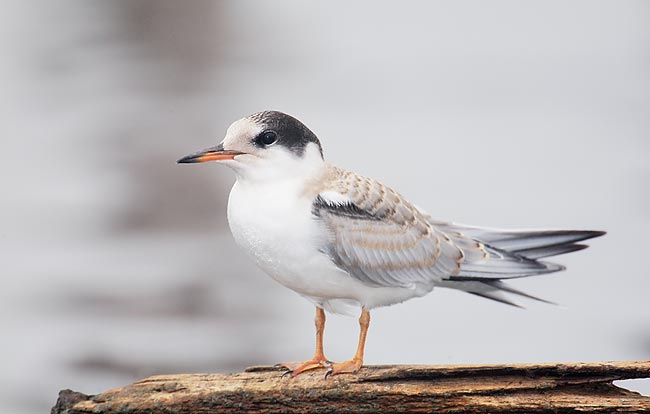
Common Tern, juvenal plumage, East Pond, Jamaica Bay Wildlife Refuge, Queens, NY
Image Copyright 2007: Arthur Morris/BIRDS AS ART
Canon 500mm f/4L IS lens with the 2X II TC and the EOS-1D Mark III. ISO 800. Evaluative metering +1 2/3 stops: 1/200 sec. at f/8.
I created this image on a totally foggy morning. Note that I had to add nearly two stops of light to come up with a decent histogram (with at least some data in the fifth histogram box). If you had seen the image below on the back of your camera, would you have deleted it???
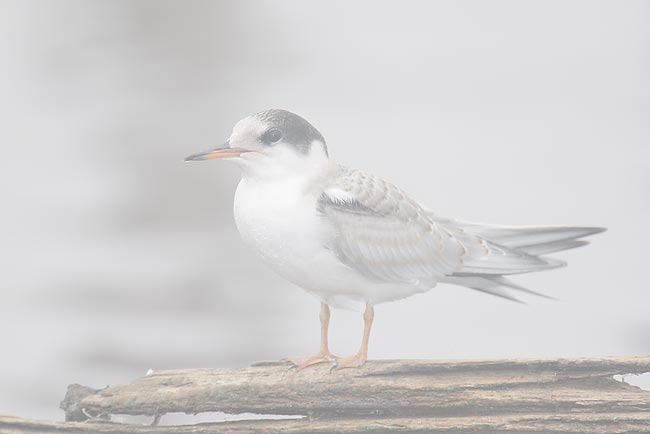
Many nature photographers fail to realize the potential of digital images made in foggy conditions. Using simple levels and curves adjustments as described in Digital Basics it took about two minutes to optimize this photograph.
DEPTH-OF-FIELD/AN OLD DOG LEARNS SOME NEW THINGS…
I recently received an e-mail suggesting that I add something to the Mark III User’s Guide (http://www.birdsasart.com/MARK%20III%20USER%20GUIDE.htm) to remind folks doing the micro-adjustments that depth-of-field extends twice as far behind the point of focus than in front of the point of focus. If this were true, then the lines in front of the point of focus would not and should not be as sharp as the corresponding lines behind the point of focus. I recalled a conversation that I had with E.J. Peiker, a computer and digital expert and a fine photographer as well. (You can check out E.J.’s Duckshop workshops here: http://www.ejphoto.com/Duckshops.htm. Be sure to check out the 2007 Duckshop galleries and the other galleries as well. I just did and was reminded of how talented EJ is.)
In any case, it was EJ who explained to me that when you are using a long lens with the subject at fairly close range depth-of-field in front of and behind the subject is equal. Only when you approach the hyperfocal distance is there lots more depth-of-field behind the subject than in front of the subject. (When the lens is focused at the hyperfocal distance, the depth-of-field extends from half the hyperfocal distance to infinity.) With super-telephoto lenses, the hyperfocal distance is measured in thousands of feet; thus, when you are photographing a focus test chart at most distances, the lines in front of the point of focus and those behind it should appear equally sharp; the depth-of-field will be distributed 50-50 in front of and behind the point of focus. If the lines in front of and behind the point of focus are not equally sharp, then your rig is either back-focusing or front-focusing.
E.J. suggested that I confirm his statements with an on-line depth-of-field calculator. A quick Google search turned up this amazing site: http://www.dofmaster.com/dofjs.html. A short visit not only confirmed what E.J. said, but provided a wonderful tutorial on depth-of-field and related topics. You simply plug in the camera, the focal length, the aperture, and the distance to the subject, hit calculate, and a table appears that lists the following: Subject distance 16 ft, Depth-of-field/Near limit 16 ft, Far limit 16 ft, Total 0.07 ft, In front of subject 0.04 ft (50%), Behind subject 0.04 ft (50%), Hyperfocal distance 6305.7 ft, and the Circle of confusion 0.023 mm. (I need to learn what that is…)
In any case, here are some interesting things that this simple calculation pointed out: the total depth-of-field in the example above is only .84 inches; the depth-of-field extends to less than one half inch in front of and less than one half inch behind the point of focus. The hyperfocal distance is 6305 feet. If you focused at that distance, then everything from 6305 feet to infinity would be in focus as would everything between 3152.5 feet and the point of focus. At close (and at intermediate) range, depth-of-field is always 50-50 in front of and behind the point of focus.
If you change your aperture to f/22, you come up with this: Total 0.29 ft, In front of subject 0.14 ft (50%), Behind subject 0.15 ft (50%). This means that the total depth-of-field at f/22 would be only 3.48 inches. How does this affect you in the field? If you have a Brown Pelican staring right at you, then you need to focus half way between the tip of the bill and the eye to have any chance of getting everything sharp… In other words, for folks using telephoto lenses the old 1/3 in front, 2/3 behind is total bunk.
I plan to spend quite a bit of time learning more about depth-of-field and you might enjoy doing the same. Thanks again E.J.!
BTW, here is a great site for converting feet to inches (or anything to anything): http://www.onlineconversion.com/auto_convert.pl
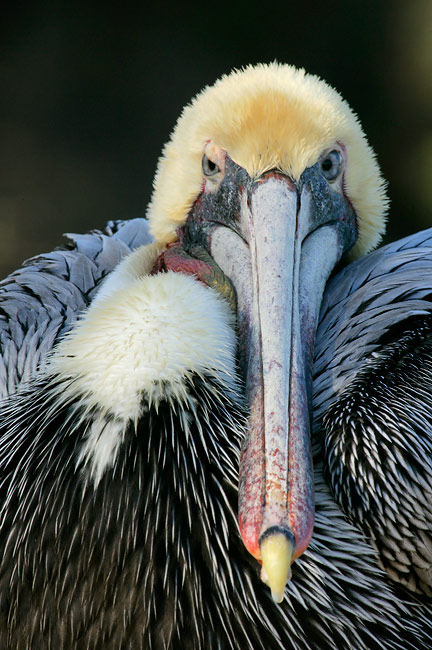
Brown Pelican, LaJolla, CA
Image Copyright 2007: Arthur Morris/BIRDS AS ART
Canon 500mm f/4L IS lens with the 1.4X II TC and the EOS 1Ds MII. Image created at f/32. Additional details unavailable.
Here it was important to use a small aperture and to focus halfway between the tip of the bill and the eyes.
MY USED EOS 1Ds MII FOR SALE/PRICE REDUCED
I am offering my EOS 1Ds MII camera body for sale for $4500 plus shipping. This 1Ds MII has been my very favorite Canon pro body for nearly two years. The camera is in perfect operating order and in very good to excellent condition with a few small paint nicks on the lower right corner and a few tiny ones elsewhere. The sale includes two Canon batteries, the charger, the original box with all materials, cords, camera strap, CDs, manuals (in English and Spanish) and everything else that was in the box! I would be glad to sign the body with a silver Sharpie pen should you so desire. Please do not request a photo of the camera as it is accurately described and priced to sell. If you are seriously interested, please call me immediately at 863-692-0906. Please leave a message and a phone number if necessary.
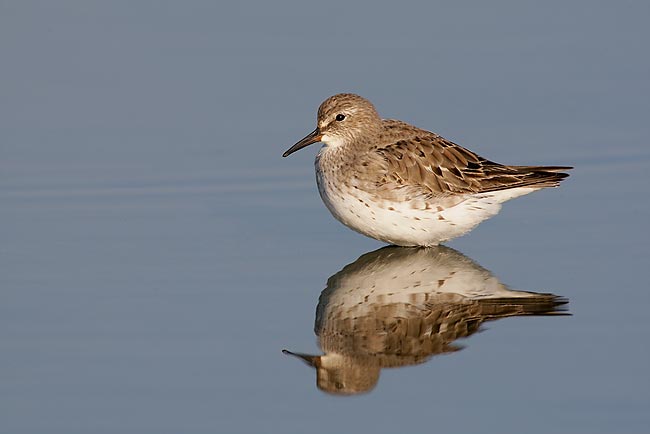
White-rumped Sandpiper, worn, molting adult, East Pond, Jamaica Bay Wildlife Refuge, Queens, NY
Image Copyright 2007: Arthur Morris/BIRDS AS ART
Canon 600mm f/4L IS lens with the 2X II TC and the EOS-1D Mark III. ISO 640. Evaluative metering +2/3 stop: 1/500 sec. at f/11.
When I saw this bird and its beautiful reflection, I went back to the spot where I had left my 500mm lens. When I saw that Mike Cornwell was using his macro lens, I asked if I could borrow his 600 and he said “Yes.” (Later on he got to crawl around with my 500 and could not believe how much easier it was with the lighter lens…) As I considered the image that I wanted to create, I noted that if I got lower the background became green, so I simply stood behind my tripod, approached slowly, and created the image that I had seen in my mind’s eye. Mike is strongly considering getting a 500 and I have vowed never to be at JBWR without my 600… The increase in magnification made things so much easier…
BEST OF FLORIDA NATURE PHOTOGRAPHY WORKSHOP & TOUR
Jim Neiger of “Flight School Photography” and James Shadle of “In the Field Workshops” are proud to present the “Best of Florida” workshop series, scheduled at the best time of year, the best weather, the best species, the best colors, the best group size and the great instruction. For the first time, a single workshop experience will combine two of Florida’s most desirable locations. The workshops will include the best of central (Snail Kites) and west-central (Roseate Spoonbills in mega-breeding plumage) Florida’s natural photographic experiences. The “Best of Florida” workshops will be led by instructors with unparalleled knowledge of the locations and the subjects found there.
The eight day
workshops will feature the unsurpassed avian opportunities of both
central and west central Florida in peak season. You will enjoy four
days of learning and photography in central Florida with Jim Neiger and
four days of learning and photography in west central Florida with James
Shadle. This unique arrangement allows you to be exposed to widest range
of subjects and habitats imaginable. The subjects and habitats are not
the only thing that has a wide range. You will also be exposed to very
qualified, yet different instructional styles.
Optional: two days of
Photoshop
Techniques And Tips Simplified with Robert O’Toole.
In this optional extension, you will have a chance to learn to effectively optimize the images that you created on the Best of Florida tour so that they look fantastic. (Most folks make their images look worse in Photoshop; what sense does it make to spend tens of thousands of dollars on equipment and travel and then ruin the images that you have made in Photoshop?) APTATS workshops are designed for the Bird photographer with an emphasis on simplicity and will be led by Robert O’toole in a relaxed and personalized atmosphere. You can learn more about Robert here: www.RobertOToolePhotography.com.
To learn more about the Best of Florida Workshops click here: http://www.bestoffloridaworkshops.com/. Follow the links for rates and dates. This spectacular trip will surely sell out very quickly so do not hesitate if you are seriously interested.
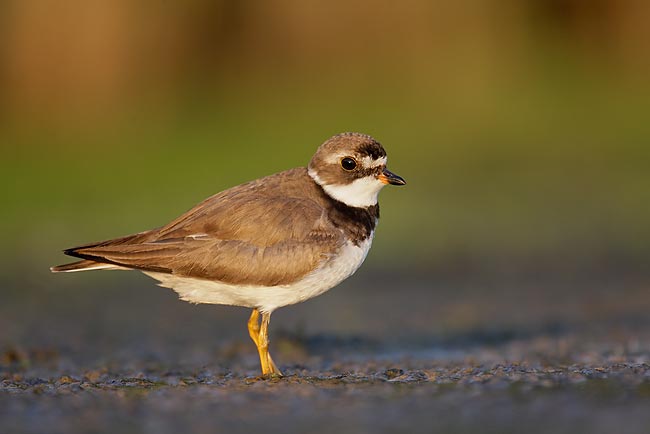
Semipalmated Plover, worn, molting adult, East Pond, Jamaica Bay Wildlife Refuge, Queens, NY
Image Copyright 2007: Arthur Morris/BIRDS AS ART
Canon 500mm f/4L IS lens with the 1.4X II TC and the EOS-1D Mark III. ISO 640. Evaluative metering +1/3 stop: 1/640 sec. at f/5.6. Central sensor w/AI Servo AF.
Early morning light and a ground level approach are a wonderful combination. I spent most of my last morning at the East Pond at the corner of the pond where there were no distracting Mute Swan feathers and a small pool with nice reflections. This bird landed just to the left of the pool.
BAA/ABP II KUDOS
Via e-mail from Francesca Albini:
Hi Artie, I did receive my copy of ABP II and was amazed that it arrived in Mexico in less than one week. And of course I've been reading it again and again since then! As other folks have said, the photographs are really outstanding and alone they are a great reason to buy the CD. The captions that come with each one of them are a great way to learn (and that's what I love about your bulletins as well). Just looking at the settings you used and your explanations as to what you did and why are incredibly educational. The text is brilliant as usual and even if there are some themes (such as safari or tundra photography for instance) that I will probably never be able to experience personally, I enjoyed reading them as well.
I still don't have the original (first) book though and I am looking forward to buying it; inspired by your wonderful work I finally took the plunge, sold my motorcycles, sold my wonderful 400mm 55.6 lens, and ordered a 500mm f/4 lens! So this is not a good moment for my credit card. Next month I hope I to get the Gitzo tripod and the Wimberley head from BAA. I hope I will be able to catch one of the last copies before they are all gone and won't have to wait for the new edition; how could they possibly stop printing such a great book?
Anyway: I wanted to thank you for helping us novice photographers out in so many ways. I really hope that one day I will be able to portray Mexican birds beautifully and try to send a message to our people. We have so many wonderful, endangered species here but most folks just don't know anything about them. I started bird watching just a couple of years ago, but I immediately understood that it was going to become the most important part of my life. Then I realized that I wanted to share some of the beauty I was able to observe out in the field with other people so learning about bird photography was the next step. I also happen to be an illustrator or, at least that's what I studied in college, but I'm a very slow painter and I really like being able to see the results quickly thanks to digital photography. I hope I will be able to paint as well but my main interest for now will be bird photography.
If you ever happen to come to southern Mexico in the state of Chiapas (I know, that's most unlikely to happen, but who knows!), just let me know. As we say in Mexico, "My house, is your house as well!"! Thanks so much for sharing your wonderful work; you really are a great artist! ¡Saludos y buena suerte! Your friend from Mexico, Francesca
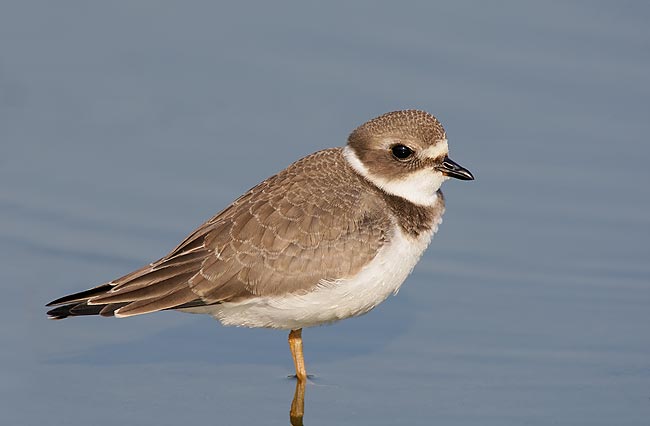
Semipalmated Plover, fresh juvenal plumage, East Pond, Jamaica Bay Wildlife Refuge, Queens, NY
Image Copyright 2007: Arthur Morris/BIRDS AS ART
(Borrowed) Canon 600mm f/4L IS lens with the 2X II TC and the EOS-1D Mark III. ISO 640. Evaluative metering +2/3 stop: 1/500 sec. at f/10.
Note the differences between the worn adult (preceding image) and this fresh juvenile. The young bird features upperparts feathers with neatly scalloped fringes, an almost all-black bill, and a much lighter breast band than the adults. Again, see Shorebirds; Beautiful Beachcombers (http://www.birdsasart.com/books.html#SHOREBIRDS) for the short course on aging and identifying migrant North American shorebirds. (Note: the tail of another bird and its reflection were removed from this image from behind the bird quickly and easily using Robert O’Toole’s Quick Masking techniques as described in his APTATS PDF (on CD only): http://www.birdsasart.com/aptats.htm.
BreezeBrowser Pro 1.7.2 RELEASED
Breeze Systems announced yesterday the immediate availability of BreezeBrowser Pro 1.7.2. This, the latest version of their acclaimed image browsing and raw conversion software allows Canon EOS 40D users to take advantage of BreezeBrowser Pro's high quality raw conversions (including combined conversions), detailed shooting data display, and focus point overlay. A fully functional 15 day trial version can be downloaded from http://www.breezesys.com/. BreezeBrowser Pro is Windows based downloadable software developed and marketed by Breeze Systems Ltd. It is available for US $69.95 or for US $89.95 when bundled with Downloader Pro; the price includes one year's free upgrades.
If you learned about Breeze Systems products from us here at BAA, we ask that you pay for your purchases here: http://www.birdsasart.com/breezebrowser,htm If you purchase through us we make a few bucks and it helps pay for these informative, free Bulletins which take about 8-10 hours on average to prepare. Thanks.
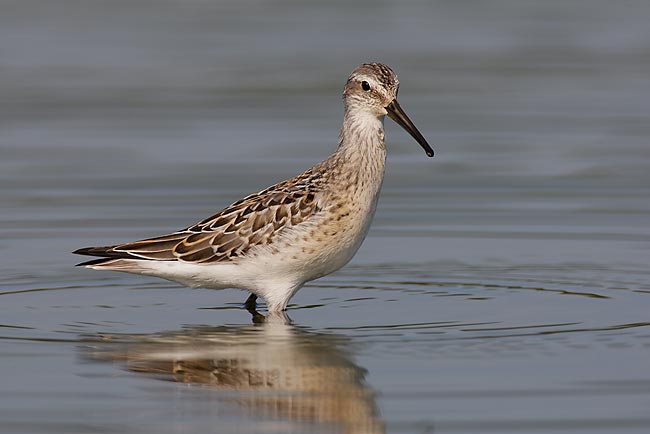
Stilt Sandpiper, juvenal plumage, East Pond, Jamaica Bay Wildlife Refuge, Queens, NY
Image Copyright 2007: Arthur Morris/BIRDS AS ART
(Borrowed) Canon 600mm f/4L IS lens with the 2X II TC and the EOS-1D Mark III. ISO 640. Evaluative metering +2/3 stop: 1/500 sec. at f/10.
This was my very favorite image taken during our last morning stalking lesson. With the 2X TC I was forced to use only the central sensor; I attempted to keep the sensor in the bird’s upper breast and used a bit of extra depth-of-field to ensure that the eye would be sharp.
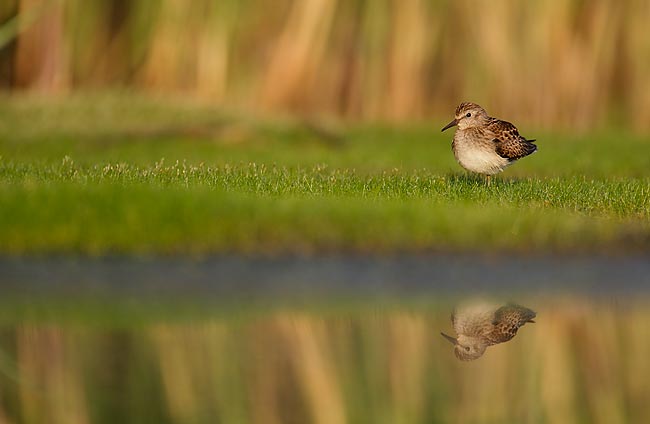
Least Sandpiper in fresh juvenal plumage, East Pond, Jamaica Bay Wildlife Refuge, Queens, NY
Image Copyright 2007: Arthur Morris/BIRDS AS ART
Canon 500mm f/4L IS lens with the 1.4X II TC and the EOS-1D Mark III. ISO 800. Evaluative metering +1/3 stop: 1/1000 sec. at f/6.3.
Here I used the central sensor and One-Shot AF. I focused on the bird and then recomposed to create this environmental portrait.
THE ART OF BIRD PHOTOGRAPHY/SOFT COVER EDITION: LATEST NEWS
We are in the process of self-publishing the soft cover edition of “The Art of Bird Photography.” We may possibly have them in stock before the end of the year. We still have very few copies of slightly damaged or mis-signed books for sale at the regular price; please call before placing an order to check on availability.
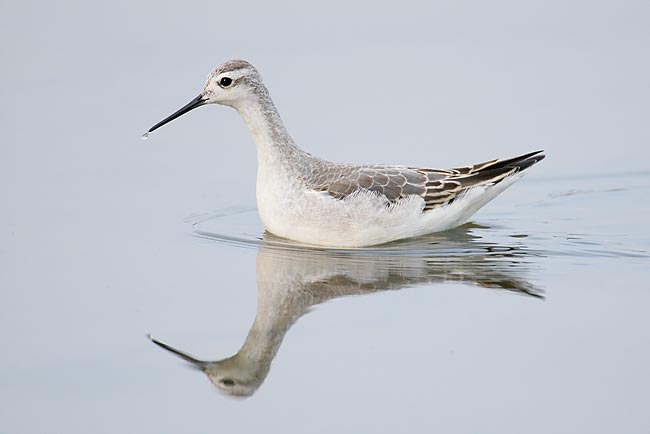
Wilson’s Phalarope, juvenile molting to first winter plumage, East Pond, Jamaica Bay Wildlife Refuge, Queens, NY
Image Copyright 2007: Arthur Morris/BIRDS AS ART
Canon 500mm f/4L IS lens with the 2X II TC and the EOS-1D Mark III. ISO 1600. Evaluative metering +1 1/3 stops: 1/250 sec. at f/8.
On a white sky afternoon, I needed to add lots of light to move the histogram to the right. That left me with a relatively slow shutter speed. As the phalaropes (there were three of them) were swimming and spinning about as expected, I held the shutter button down whenever a bird was parallel to the imaging sensor in hopes of creating at least one sharp image. Against all odds, I was able to create just one sharp one, this, with a droplet of water on the tip of the bird’s slim bill.
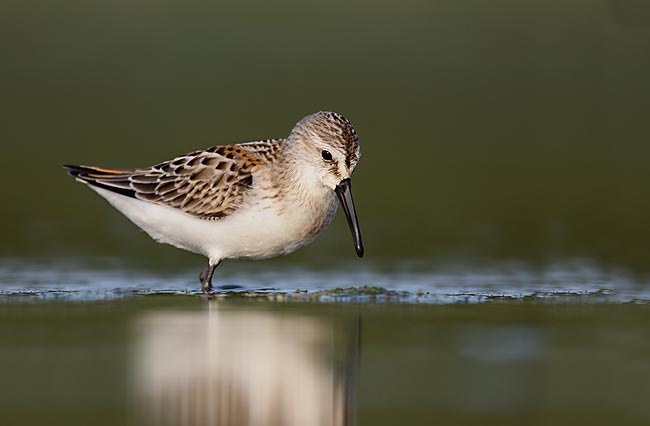
Western Sandpiper in juvenal plumage, East Pond, Jamaica Bay Wildlife Refuge, Queens, NY
Image Copyright 2007: Arthur Morris/BIRDS AS ART
Canon 500mm f/4L IS lens with the 2X II TC and the EOS-1D Mark III. ISO 400. Evaluative metering +1/3 stop: 1/400 sec. at f/8.
Here is another situation where I made lots of images in short order whenever the bird was parallel to the imaging sensor. Part of an out-of-focus bird to the rear of the subject was Quick-Masked out of the frame and canvas was added in front of the bird.
IPT UPDATES
Note: All presently scheduled North American IPTs except San Diego (see same below) are currently sold out with waiting lists.
Bosque #1: "The Fall Color IPT" NOV 13-15, 2007. Slide Program on the evening of NOV 12. 3-DAY: $999. (Limit 14; Sold Out). Co-leader: Robert O'Toole. Guest leader (DAY 3 only): Andy Rouse. This IPT should feature a better chance for a day or two of the rare south winds that drastically improve flight photography and will definitely feature the brightest fall-color cottonwoods.
Bosque #2: "The Pre-Thanksgiving IPT" NOV 18-20, 2007. Slide Program on the evening of NOV 17. 3-DAY: $999. (Limit 14; Sold Out). Co-leader: Robert O'Toole, Robert Amoruso, & Alfred Forns. Guest leader: Andy Rouse. This IPT will feature increasing numbers of geese and cranes with lots of great opportunities. In 2007, I will again be hosting a Thanksgiving Day luncheon at Las Lunas Mansion, a fine restaurant in an historic building. You will need to reserve a spot and pay in advance. Details TBA; strictly limited to 50 folks.
Bosque #3: "The Post-Thanksgiving IPT" NOV 24-26, 2007. Slide Program on the evening of NOV 23. 3-DAY: $999. (Limit 14: Sold Out). Co-leaders: Robert O'Toole, Robert Amoruso, and Alfred Forns. This IPT is scheduled on dates that I consider peak for Bosque. (There may be a Full Moon Add-on NOV 23; details TBA.) If you register for this one, hold off on buying your plane ticket if you might be interested in the add-on.) In 2007, I will again be hosting a Thanksgiving Day luncheon at Las Lunas Mansion, a fine restaurant in an historic building. You will need to reserve a spot and pay in advance. Details TBA; strictly limited to 50 folks.
BIG NEWS! SW FLA Post X-mas IPT: DEC 27-29, 2007. Slide program on the of evening Wednesday, DEC 26, 2006. 3-DAY: $1029. (Limit 12; Sold Out). Co-leaders: Alfred Forns, & Robert O'Toole. Joining us as guest co-leader will be full time professional photographer John Moran, Florida's unofficial Photographer Laureate. You can learn about John’s amazing work here: www.johnmoranphoto.com. John will be doing his program, “Journal of Light: A Photographer's Search for the Soul of Florida" for the group on Wednesday, DEC 26 at 3:30 pm. John’s work is so different from mine and from everyone else’s that he has been a huge inspiration to me over the past two years. We will be visiting Sanibel Island, Venice Rookery, Cape Coral, and possibly Little Estero Lagoon (depending on the tides). Herons, egrets, gulls, terns, skimmers, shorebirds, both pelicans, Osprey, Burrowing Owl, and lots more. Roseate Spoonbill and Wood Stork possible.
NEW: San Diego IPT: JAN 20-23, 2008. Slide program on the Saturday early evening of JAN 19. 4-DAYS: $1399. (Limit 12; openings: 8.) LaJolla, LaJolla Shores Beach, Coronado, and Santee Lakes. Brown Pelicans in spectacular breeding plumage, Heerman’s & Western Gulls, Marbled Godwits & lots more shorebirds, Wood & Ring-necked Ducks & Lesser Scaup. Great flight photography. And lots more.
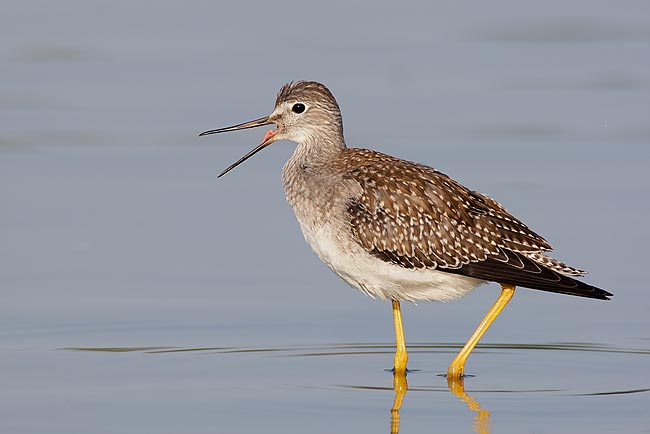
Lesser Yellowlegs in moderately worn juvenal plumage, East Pond, Jamaica Bay Wildlife Refuge, Queens, NY
Image Copyright 2007: Arthur Morris/BIRDS AS ART
(Borrowed) Canon 600mm f/4L IS lens with the 2X II TC and the EOS-1D Mark III. ISO 640. Evaluative metering +2/3 stop: 1/500 sec. at f/11.
I was able to get close to this bird as it finished preening. Again, I placed the central sensor on the bird’s upper breast and used AI Servo AF and a bit of extra depth-of-field. (Note: Even at f/11 the dof was about 1/3 of an inch in front of and behind the point of focus…)
Best and love and great picture-making to all,
artie
Note: Arthur Morris has been a Canon contract photographer since 1994 and continues in that role today. Hunt's Photo of Boston, MA is a BAA sponsor as is Delkin Devices. Back issues of all BAA Bulletins can be found in the Bulletin Archives which may be accessed from the home page at www.birdsasart.com